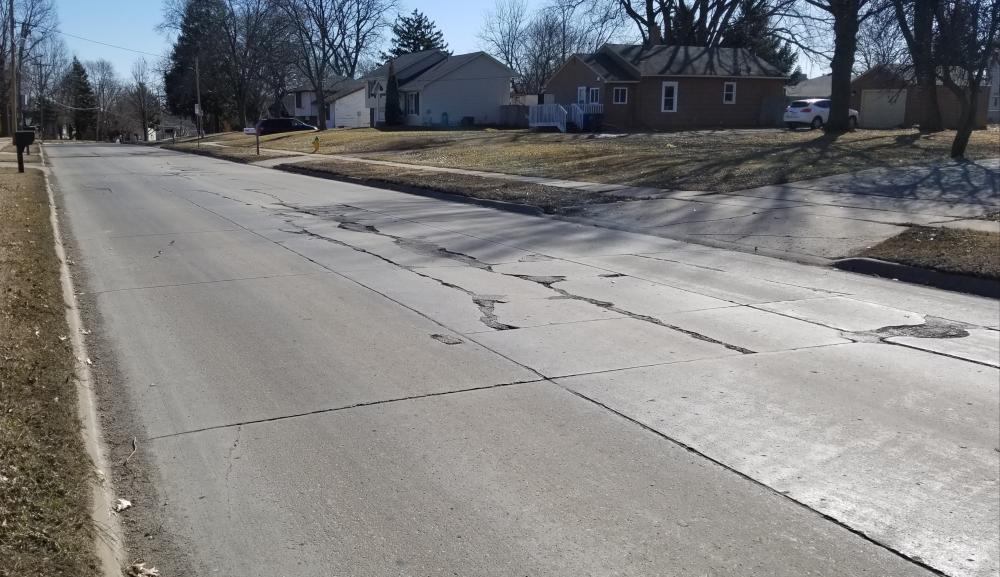Des Moines officials propose spending ‘historic’ $427.6 million on street improvements
The restoration of the city’s 2,200 miles of streets would be completed over a seven-year period. 'We’re accelerating it beyond anyone’s belief,' the city’s mayor says.

KATHY A. BOLTEN Mar 3, 2020 | 3:57 pm
4 min read time
854 wordsAll Latest News, Government Policy and Law, TransportationEvergreen Avenue between Southeast 18th Street and Southeast 20th Street.
Motorists who drive on the city of Des Moines’ 2,200-plus miles of streets during the next seven years will likely be frustrated by the myriad “construction ahead” signs that will dot roadsides.
The frustration will be worth it, city officials promise.
That’s because the city is doubling the average yearly amount spent on street repairs to $61 million from $30 million, according to city documents.
“We’re able to increase [the spending] because of the local option sales tax,” Des Moines Mayor Frank Cownie said. “We had a street program going before we passed it [last year]. But now we’re accelerating it beyond anybody’s belief that we could do that amount of road work in such a short amount of time.”
More than $427.6 million is proposed to be spent to replace a significant number of Des Moines’ crumbling streets between now and June 30, 2026, said city officials, describing the amount as “historic.”
The proposed street rehabilitation is part of the city’s five-year capital improvement program that will be considered by the City Council at its March 23 meeting. It also includes work approved and budgeted between now and June 30, 2021.
In the fiscal year that begins July 1, city officials expect $7 million of local option sales tax revenue to be put toward the street improvement program. An additional $23 million from the tax will be applied to the debt service of bonds issued for street improvements and the capital improvements program. In subsequent years, the city is budgeting nearly $21 million to be applied to the debt service of bonds issued for street improvements and the capital improvements program.
Improving the city’s streets will likely boost property values and make Des Moines more attractive for businesses and others to move to, city officials said.
“What we’re doing every step of the way is creating a better foundation for the future of the city,” Cownie said.
43% of city streets in poor or worse condition
A survey by the city’s public works department in 2019 found that 43% of streets were in poor or very poor condition. Another 35% were rated as good condition.
“Our streets are being maintained for much longer than they were designed for in earlier decades,” said Jonathan Gano, public works director. “We’ve extended their life just a bit longer than we should have in many cases. It’s left us with roads that are very susceptible to the vicissitudes of weather and pothole formation.”
Over the past few decades, most of the city’s older streets have been repaired by adding a layer of asphalt, a process that’s been done too many times, Gano said.
“It’s time to build a better road from the bottom up,” he said.
In most instances, old pavement will be removed; the new streets that will be installed will meet 2020 design standards, Gano said.
Water is the biggest enemy of concrete, Gano said. Once water seeps into concrete, it can cause the substance to heave, crack or, in some instances, deteriorate into powder.
The problems are typically caused by water being trapped in mud directly below the streets. Rather than pouring the concrete over packed dirt, it will be put over several-inches-thick gravel.
“That gives the water a place to go to get away from the pavement,” Gano said. “The other innovation is adding some drainage underneath the gravel. … As the water moves through the stone, it moves freely and doesn’t take any of the subgrade material with it, gets into a drainpipe, and drains away into the roadside or into a storm sewer.”
Gano estimates the newly paved streets will last 50 to 60 years without any major maintenance.
Where will work be done?
The city used to apportion maintenance dollars to wards, with each one getting 25%, Gano said.
“The infrastructure is not evenly distributed among the wards, so there were places that were getting less dollars per mile of roadway,” he said. “When you do that for decades in a row, you will see an accelerated degradation in those areas as opposed to other parts of town.”
The city’s streets are analyzed every two years. The information that is collected is put into a computer program whose algorithm selects the optimum recommendations for maintenance and reconstruction, Gano said. That information is compared with other projects such as storm and sanitary sewer installations, utility work, and work by waterworks as well as other street projects.
“We have to stage projects so they don’t conflict,” said Steve Naber, city engineer. The city’s five-year capital improvement program includes a list of streets that will be improved and when the construction work will occur.
City officials said all of Des Moines’ major streets will see improvements, as will neighborhood streets.
“We take a completely agnostic approach to what side of town gets maintenance dollars,” Gano said. “Our residents live and work and go to school all over the city. We take a holistic approach to maintaining and improving the infrastructure.
Learn more
To learn more about Des Moines’ proposed street improvement program, go to DSM.city/streets.











